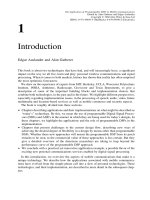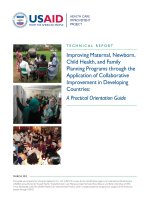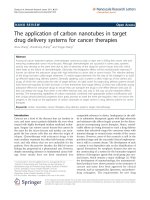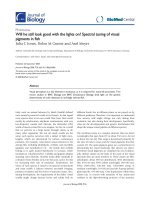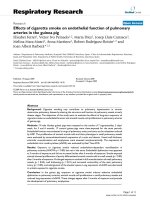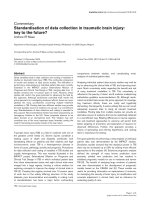On the application of data assimilation in the singapore regional model
Bạn đang xem bản rút gọn của tài liệu. Xem và tải ngay bản đầy đủ của tài liệu tại đây (3.04 MB, 191 trang )
ON THE APPLICATION OF DATA ASSIMILATION
IN THE SINGAPORE REGIONAL MODEL
SUN YABIN
(M.Sc., TJU)
A THESIS SUBMITTED
FOR THE DEGREE OF DOCTOR OF PHILOSOPHY
DEPARTMENT OF CIVIL ENGINEERING
NATIONAL UNIVERSITY OF SINGAPORE
2010
i
Acknowledgements
I would like to express my sincere gratitude to my supervisor, Professor Chan Eng Soon,
for his continuous support on my research. His immense knowledge and constructive
criticisms have been of great value for this study. Without his guidance, this work would
not have been possible.
I am deeply grateful to my co-supervisor, Assoc. Professor Vladan Babovic, who
guided me throughout this research, and gave me the opportunity to work with other
researchers in Singapore-Delft Water Alliance. His rigorous attitude and eternal
enthusiasm in research have exerted a remarkable influence on me, and will accompany
me in my entire career.
My sincere thanks also go to Professor Liong Shie-Yui, Professor Ong Say Leong,
Professor Cheong Hin Fatt and Dr. Herman Gerritsen, for their insightful comments and
excellent suggestions on my thesis.
Special thanks to Dr. Sisomphon, who introduced me to Delft3D modelling, and
proposed numerous inspiring ideas on my research. The stimulating discussions with her
have established a solid basis for this thesis. Thanks are extended to my colleagues in
Singapore-Delft Water Alliance, Mr. Klaas Pieter, Ms. Tay Hui Xin, Ms. Arunoda, Ms.
Wang Xuan, Mr. Alamsyah Kurniawan, Mr. Pavlo Zemskyy, Dr. Rao Raghu and Dr. SK
ii
Ooi, as well as my colleagues in Deltares, Dr. Daniel Twigt and Dr. Firmijn Zijl, for the
enjoyable working experience we share together and their help on my theis.
I am also thankful to Mr. Krishna and Ms. Norela from the Hydraulic Lab, for their
essential assistance in various aspects.
The financial support from the National University of Singapore is gratefully
acknowledged.
Additional thanks to my friends, Dr. Liu Dongming, Mr. Lin Quanhong, Mr. Chen
Haoliang, Mr. Zhang Wenyu, Dr. Gu Hanbin, Mr. Xu Haihua, Dr. Dulakshi, Dr. Ma
Peifeng, Dr. Wang Zengrong, Dr. Cheng Yonggang, Dr. Zhou Xiaoquan, Mr. Zhang Xu
and Mr. Wang Li, for all the great time we spent together and the everlasting friendship
we have.
Heartfelt thanks to my dear parents and my wife, who continuously support me with
their love. Without their understanding and encouragement, it would have been
impossible for me to accomplish this work.
iii
Table of Contents
Acknowledgements i
Table of Contents iii
Summary viii
List of Tables xi
List of Figures xiii
List of Symbols xvii
Chapter 1 Introduction 1
1.1 Background
1
1.2 Review of Data Assimilation
3
1.2.1 Classification
3
1.2.2 Methodology
5
1.3 Overview of Singapore Regional Model
6
1.4 Objectives of Present Study
8
1.5 Organization of Thesis
10
Chapter 2 Chaos Theory 13
iv
2.1 Introduction
14
2.2 Time-delay Embedding Theorem
15
2.3 System Characterization
16
2.4 Phase Space Reconstruction
18
2.4.1 Time Delay
19
2.4.2 Embedding Dimension
m
20
2.5 Time Series Prediction
22
2.5.1 Local Model
22
2.5.2 Standard Approach
24
2.5.3 Inverse Approach
24
2.5.4 Lorenz Time Series Prediction
26
Chapter 3 Artificial Neural Networks 36
3.1 Introduction
36
3.2 Neuron
37
3.3 Activation Function
38
3.4 Multilayer Perceptron
39
3.5 Back-propagation Algorithm
40
3.6 Application of Multilayer Perceptron
41
3.6.1 Network Architecture
41
3.6.2 Lorenz Time Series Prediction
42
v
Chapter 4 Kalman Filter 47
4.1 Linear Kalman Filter
47
4.2 Extended Kalman Filter
50
4.3 Steady-state Kalman Filter
52
4.4 Application of Kalman Filter in Error Distribution
53
Chapter 5 Singapore Regional Model 56
5.1 Delft3D-FLOW
56
5.1.1 Introduction
56
5.1.2 Governing Equations
57
5.1.3 Numerical Aspects
60
5.2 Singapore Regional Model
62
5.2.1 Model Set-up
62
5.2.2 Numerical Simulation
63
Chapter 6 Error Prediction with Local Model and Multilayer Perceptron 72
6.1 Introduction
72
6.2 Application of Local Model in Error Prediction
73
6.2.1 Chaos Identification
73
6.2.2 Parameter Determination
73
6.2.3 Results
74
6.3 Application of Multilayer Perceptron in Error Prediction
75
vi
6.3.1 Methodology
75
6.3.2 Results
77
6.4 Comparison between Local Model and Multilayer Perceptron
77
Chapter 7 Error Distribution with Kalman Filter and Multilayer Perceptron 94
7.1 Introduction
94
7.2 Application of Kalman Filter in Error Distribution
95
7.2.1 Error Statistics Approximation
95
7.2.2 Results
97
7.3 Application of Multilayer Perceptron in Error Distribution
97
7.3.1 Methodology
97
7.3.2 Results
99
7.4 Comparison between Kalman Filter and Multilayer Perceptron
100
Chapter 8 Use of Data Assimilation in Understanding Sea Level Anomalies 111
8.1 Introduction
111
8.2 Overview of Sea Level Anomalies
112
8.2.1 Sources of Marine Data
112
8.2.2 Extraction of Sea Level Anomalies
113
8.2.3 Statistical Analysis of Sea Level Anomalies
115
8.2.4 RADS SLA vs. DUACS SLA
116
8.2.5 Altimeter SLA vs. In-situ SLA
117
vii
8.3 Assimilation of Sea Level Anomalies into Singapore Regional Model
118
8.3.1 Prediction of SLA at Open Boundaries
119
8.3.1.1 Preprocess of SLA Time Series
119
8.3.1.2 Methodology
119
8.3.1.3 Results
121
8.3.2 Numerical Simulation of Internal SLA
121
8.4 Research in Progress and Future
122
Chapter 9 Conclusions and Recommendations 139
9.1 Conclusions
139
9.2 Recommendations
141
References 143
Appendix A 151
Appendix B 161
List of Publications 166
viii
Summary
One primary objective of this study is to develop and implement applicable data
assimilation methods to improve the forecasting accuracy of the Singapore Regional
Model. A novel hybrid data assimilation scheme is proposed, which assimilates the
observed data into the numerical model in two steps: (i) predicting the model errors at the
measurement stations, and (ii) distributing the predicted errors to the non-measurement
stations. Specifically, three approaches are studied, the local model approach (LM), the
multilayer perceptron (MLP), and the Kalman filter (KF).
At the stations where observations are available, both the local model approach and
the multilayer perceptron are utilized to forecast the model errors based on the patterns
revealed in the phase spaces reconstructed by the past recordings. In cases of smaller
prediction horizons, such as
2, 24T
hours, the local model approach outperforms the
multilayer perceptron. However, due to the less competency of the local model approach
in capturing the trajectories of the state vectors in the higher-dimensional phase spaces,
the prediction accuracy of the local model approach decreases by a wider margin when
T
progresses to 48, 96 hours. Averaged over 5 different prediction horizons, both
methods are able to remove more than 60% of the root mean square errors (RMSE) in the
model error time series, while the multilayer perceptron performs slightly better.
ix
To extend the updating ability to the remainder of the model domain, Kalman filter
and the multilayer perceptron are used to spatially distribute the predicted model errors to
the non-measurement stations. When the outputs of the Singapore Regional Model at the
non-measurement stations and the measurement stations are highly correlated, such as at
Bukom and Raffles, both approaches exhibit remarkable potentials of distributing the
predicted errors to the non-measurement stations, resulting in an error reduction of more
than 50% on average. However, the performance of Kalman filter in error distribution
deteriorates at a rapid pace when the correlation decreases, with only about 40% of the
root mean square errors removed at Sembawang and 20% at Horsburgh. Comparatively,
the multilayer perceptron is less sensitive to the correlations with a more consistent
performance, which removes more than 40% of the root mean square errors at
Sembawang and Horsburgh. In addition, the error distribution study demonstrates for the
first time that distributing the predicted errors from more measurement stations does not
necessarily produce the best results due to the misleading information from less
correlated stations. As suggested by this finding, to conduct a prior correlation analysis
among possible sites is favorable when planning the future layout of the measurement
stations.
Another major objective of this study is to analyze and predict the sea level anomalies
by means of data assimilation. Sea level anomalies are extracted based on tidal analysis
from both altimeter data and in-situ measurements. A reasonable fit between the altimeter
sea level anomalies and the in-situ sea level anomalies can be observed, indicating the
coherence and consistency of different data sources. As a demonstration of the proposed
x
data assimilation scheme, the sea level anomalies explored in this study are the spatially
and temporally interpolated DUACS sea level anomalies.
At the open boundaries of the Singapore Regional Model, the sea level anomaly time
series are predicted using multilayer perceptron with prediction horizon
24T hours.
Multilayer perceptron successfully captures the motion dynamics of the sea level
anomalies, with more than 90% of the root mean squares (RMS, quadratic mean)
removed on average. The sea level anomalies inside the model domain are then
numerically modelled by imposing the sea level anomalies predicted at the open
boundaries as driving force to the Singapore Regional Model. A reasonable
correspondence are observed between the modelled sea level anomalies and the DUACS
sea level anomalies, verifying that the internal sea level anomalies can be decently
modelled through numerical simulation provided that the sea level anomalies are properly
prescribed at the open boundaries.
xi
List of Tables
Table 2.1 Parameters in the inverse approach for Lorenz model.
35
Table 5.1 Statistics of model errors at the measurement stations.
71
Table 6.1 Parameter settings in genetic algorithm.
89
Table 6.2 Embedding parameters (
m ,
, k ) in local model.
90
Table 6.3 Statistics of residual errors at the measurement stations (local model).
91
Table 6.4 Embedding parameters (
m
,
) in multilayer perceptron.
92
Table 6.5 Statistics of residual errors at the measurement stations (multilayer
perceptron).
93
Table 7.1 Correlation coefficient between the SRM outputs at the measurement
stations and the non-measurement stations.
106
Table 7.2 Statistics of residual errors at Bukom (Kalman filter; *: best case).
107
Table 7.3 Statistics of residual errors at Raffles (Kalman filter; *: best case).
107
Table 7.4 Statistics of residual errors at Sembawang (Kalman filter; *: best
case).
108
Table 7.5 Statistics of residual errors at Horsburgh (Kalman filter; *: best case).
108
Table 7.6 Statistics of residual errors at Bukom (multilayer perceptron; *: best
case).
109
Table 7.7 Statistics of residual errors at Raffles (multilayer perceptron; *: best
case).
109
xii
Table 7.8 Statistics of residual errors at Sembawang (multilayer perceptron; *:
best case).
110
Table 7.9 Statistics of residual errors at Horsburgh (multilayer perceptron; *:
best case).
110
Table 8.1 General aspects of Jason-1 and Envisat.
137
Table 8.2 Summary of statistical analysis results of the sea level anomalies.
138
xiii
List of Figures
Figure 1.1 Variational data assimilation approach.
11
Figure 1.2 Sequential data assimilation approach.
11
Figure 1.3 Schematic diagram of simulation and forecasting with emphasis on
the four different updating methodologies
12
Figure 2.1 Lorenz time series.
28
Figure 2.2 Fourier power spectrum of Lorenz time series.
29
Figure 2.3 Correlation integral analysis for Lorenz time series.
29
Figure 2.4 Average mutual information of Lorenz time series.
30
Figure 2.5 False nearest neighbors analysis for Lorenz time series.
30
Figure 2.6 Reconstructed phase space for Lorenz model.
31
Figure 2.7 Conceptual sketch of the local model approach.
32
Figure 2.8 Flow diagram of genetic algorithm.
33
Figure 2.9 Schematic illustration of evolving process in genetic algorithm.
33
Figure 2.10 Lorenz time series prediction using local model (standard approach;
T=2).
34
Figure 2.11 Lorenz time series prediction using local model (inverse approach;
T=2).
34
Figure 3.1 Nonlinear model of a neuron.
44
Figure 3.2 Model of a single-layer perceptron.
44
xiv
Figure 3.3 Architectural graph of a multilayer perceptron with two hidden
layers.
45
Figure 3.4 Lorenz time series prediction using multilayer perceptron (T=2).
46
Figure 4.1 Linear Kalman filter algorithm.
55
Figure 4.2 Extended Kalman filter algorithm.
55
Figure 5.1 Staggered grid of Delft3D-FLOW.
66
Figure 5.2 Extent, grid and bathymetry of Singapore Regional Model.
67
Figure 5.3 Measurement stations around Singapore.
68
Figure 5.4 SRM outputs, observations and model errors at Jurong.
69
Figure 5.5 SRM outputs, observations and model errors at Horsburgh.
69
Figure 5.6 Model errors at Jurong.
70
Figure 5.7 Model errors at Horsburgh.
70
Figure 6.1 Correlation integral analysis for the model error time series at
Jurong.
80
Figure 6.2 Reconstructed phase space for the model errors at Jurong (T=2
hours).
81
Figure 6.3 Error prediction with local model at Jurong (T=2 hours).
82
Figure 6.4 Error prediction with local model at Jurong (T=96 hours).
82
Figure 6.5 Error prediction with local model at Horsburgh (T=2 hours).
83
Figure 6.6 Error prediction with local model at Horsburgh (T=96 hours).
83
Figure 6.7 Scatter diagrams of SRM outputs at Jurong.
84
Figure 6.8 Scatter diagrams of LM corrected outputs at Jurong (T=2 hours).
84
Figure 6.9 Average mutual information of the model errors at Jurong.
85
xv
Figure 6.10 False nearest neighbors analysis for the model errors at Jurong.
85
Figure 6.11 Architecture of multilayer perceptron in error prediction.
86
Figure 6.12 Error prediction with multilayer perceptron at Jurong (T=2 hours).
87
Figure 6.13 Error prediction with multilayer perceptron at Jurong (T=96 hours).
87
Figure 6.14 RMSE vs. prediction horizon at Jurong.
88
Figure 6.15 RMSE vs. prediction horizon at Horsburgh.
88
Figure 7.1 Error distribution with Kalman filter at Horsburgh (T=2 hours; Case
3).
102
Figure 7.2 Error distribution with Kalman filter at Horsburgh (T=96 hours;
Case 3).
102
Figure 7.3 Architecture of multilayer perceptron in error distribution.
103
Figure 7.4 Error distribution with multilayer perceptron at Horsburgh (T=2
hours; Case 3).
104
Figure 7.5 Error distribution with multilayer perceptron at Horsburgh (T=96
hours; Case 3).
104
Figure 7.6 RMSE vs. prediction horizon at Horsburgh.
105
Figure 8.1 Jason-1 (upper) and Envisat (lower) ground tracks.
124
Figure 8.2 Locations of the UHSLC stations.
125
Figure 8.3 Amplitudes (upper) and phases (lower) of M2 from RADS altimeter
data and from in-site measurements.
126
Figure 8.4 Along track RADS sea level anomalies for period from 14
th
to 29
th
November 2005.
127
Figure 8.5 Gridded DUACS sea level anomalies for period from 16
th
to 30
th
November 2005.
128
Figure 8.6 Comparison of sea level anomalies obtained from the RADS and
DUACS data sets with sea level anomalies obtained from UHSLC
in-situ measurements (Kelang/140; 2005).
129
xvi
Figure 8.7 Comparison of sea level anomalies obtained from the RADS and
DUACS data sets with sea level anomalies obtained from UHSLC
in-situ measurements (Cendering /320; 2005).
129
Figure 8.8 Extent, bathymetry of the Singapore Regional Model with 17
boundary support points.
130
Figure 8.9 Extracted SLA at selected Singapore Regional Model SCS,
Andaman Sea, and Java Sea boundary support points.
131
Figure 8.10 Architecture of multilayer perceptron in sea level anomaly
prediction.
132
Figure 8.11 SLA prediction with multilayer perceptron at SCS boundary (ID 9;
T=24 hours).
133
Figure 8.12 SLA prediction with multilayer perceptron at Andaman Sea
boundary (ID 4; T=24 hours).
133
Figure 8.13 SLA prediction with multilayer perceptron at Java Sea boundary (ID
15; T=24 hours).
134
Figure 8.14 SRM simulated SLA (red line) compared to DUACS SLA (blue
asterisks) at Tanjong Pagar.
135
Figure 8.15 SRM simulated SLA (left panels) compared to DUACS SLA maps
(right panels).
136
Figure A.1 Signal-flow graph of output neuron
j
.
159
Figure A.2 Signal-flow graph of hidden neuron
j
connected to output neuron
k
.
159
Figure A.3 Back-propagation algorithm cycle.
160
xvii
List of Symbols
o
A
mean water level
i
A
amplitude of a constituent
k
A
matrix that relates the state vectors
k
b
bias
k
B
matrix that relates the forcing term to the state
Cr
Courant number
C
correlation integral
d correlation dimension
d
external forces
av
E
average squared error energy
E
n
instantaneous error energy
ˆ
M
E
model errors forecasted at the measurement stations
ˆ
N
E
distributed errors at the non-measurement stations
f
Coriolis coefficient
f
nonlinear model operator
xviii
T
f
mapping function
i
F
amplitude factor of a constituent
,FF
turbulent momentum fluxes in
and
directions
T
g
alternative mapping function
i
G
phase lag of a constituent
,GG
coefficient transforming orthogonal curvilinear co-ordinates to Cartesian
rectangular co-ordinates
h
nonlinear measurement operator
H
Heaviside step function
H
t
astronomic tidal level
k
H
matrix that relates the state to the measurement
i
index of a constituent
A
B
I
average mutual information between
A
measurements and
B
measurements
I
average mutual information between
i
x
and
i
x
k
no. of nearest neighbors / no. of relevant constituents
k
K
Kalman gain
m
embedding dimension
,
M
M
sources/sinks of momentum in
and
directions
xix
M matrix of the numerical model outputs at the measurement stations
N
length of the time series
N matrix of the numerical model outputs at the non-measurement stations
A
Pa
individual probability density for measurements
A
,
AB
Pab
joint probability density for measurements
A
and
B
B
Pb
individual probability density for measurements
B
i
P
population of chromosomes
,PP
hydrostatic pressure gradients in
and
directions
a
k
P error covariances for the analysis estimate
f
k
P error covariances for the forecast estimate
Q
global source/sink per unit area
k
Q
model error covariance
r
correlation coefficient
2
i
R
m square of the Euclidian distance between
i
x
and
N
N
i
x
RMS
root mean square / quadratic mean
RMSE
root mean square error
k
R
measurement error covariance
t
time
T
lead time (prediction horizon)
,,uvw
flow velocities in
x
,
y
and
z
directions
xx
k
u
linear combiner output
k
u
forcing term
,UV
depth-averaged velocity in
and
directions
v
correlation exponent
k
v induced local field (activation potential)
k
v
measurement noise
o
i
Vu
astronomical argument of a constituent
kj
w
synaptic weights of neuron
k
1k
w
model noise
i
x
scalar time series
j
x
input signals
i
x
phase space vector
N
N
i
x nearest neighbor of
i
x
k
x
state vector
a
k
x
analysis state estimate
f
k
x
forecast state estimate
t
x
current state
tT
x
future state
ˆ
tT
x
‘expected’ future state
xxi
k
y
output signal
k
z
measurement vector
momentum constant
threshold distance
j
n
local gradient
free surface elevation above the horizontal reference plane
learning rate
i
observed values
'
i
Singapore Regional Model outputs
linearized bottom friction coefficient
3
D
eddy viscosity due to 3D turbulence
mol
kinematic viscosity
back
V
background vertical eddy viscosity
,
horizontal orthogonal curvilinear co-ordinates
spatial correlation for the model errors
0
reference water density
vertical co-ordinate
mei
standard deviation for the measurement errors
mo
standard deviation for the model errors
time delay
xxii
activation function
mapping function
flow velocity in
direction
i
angular velocity of a constituent
Chapter 1
Introduction
1.1 Background
Oceanographic system forecasting is of prime importance for safe navigation and
offshore operations as well as understanding oceanographic physics, such as ocean waves,
ocean currents, transport and mixing characteristics. Great effort has been devoted to
developing different approaches to forecast the oceanographic system. These approaches
can be classified into three general categories: numerical models, data mining and data
assimilation.
With the development of computer science, the use of numerical models that are
governed by a set of mathematical equations is the preferred way for researchers to
predict the future of oceanographic system. Numerous numerical models have been
developed under different numerical environments to describe the movement of local
water or even the circulation of entire ocean (Pugh, 1996; Palacio et al., 2001; Marchuk
et.al, 2003). The improvement of numerical calculation and the increasing power of
computers made people extremely confident in the competence of the numerical models.
It was believed that numerical models could become complex enough to reach any level
of precision, simply by refining the model scales and calculating for long enough.
CHAPTER 1. INTRODUCTION
2
However, some researchers have indicated that the numerical models are far from being
perfect as they are indeed only models of reality (Madsen et al., 2003; Babovic et al.,
2005; Mancarella et al., 2007). The prediction capability of the numerical models could
be diminished due to certain inherent delimiting factors, such as simplifying assumptions
employed in the numerical models, errors in the numerical schemes, inaccuracy in the
model parameters and uncertainty in the prescribed forcing terms. Therefore, numerical
models tend to produce imperfect model results even if the governing laws can model the
prediction framework with good aptness.
The opposite approach to numerical models in oceanographic forecasting is
encompassed in the term data mining. The original philosophy behind data mining is the
attempt to circumvent the numerical models. Data mining has become an important tool
to transform data into information as a process of extracting hidden patterns from data. In
domains where the numerical models are poor and data have been collected over long
periods, through data mining the researchers would be able to capture and reproduce the
dynamics of the system just by analyzing the data (Cipolla, 1995; Wang, 1999; Poncelet
et al., 2007). However, the performance of data mining critically relies on the data quality
and availability. Sometimes the size and complexity of the data make it difficult to find
useful information (Kamath, 2006; Hong et al., 2009). Discarding the experience
accumulated by the refinement of theories also makes data mining less convincing to the
researchers who wonder about the science still undiscovered in the data.
With the objective to take the best of both numerical models and observed data, a
method referred to as data assimilation was designed, following the terminology in
